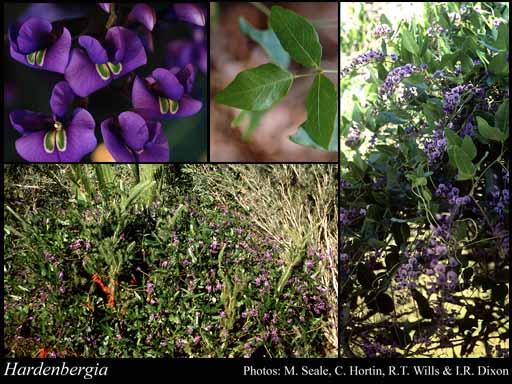- Reference
- Enum.Pl. 40 (1837)
- Name Status
- Current

Scientific Description
Family Papilionaceae. Phaseoleae.
Sometimes included in Leguminosae.
Habit and leaf form. Shrubs (prostrate-twining), or lianas; evergreen; not resinous. Plants unarmed. Plants with neither basal nor terminal concentrations of leaves. Young stems cylindrical, or tetragonal. Climbing (or trailing); stem twiners. Twining anticlockwise (‘dextrorotatory’). Mesophytic, or xerophytic. Leaves small to medium-sized; alternate; spiral; ‘herbaceous’, or leathery; not imbricate; petiolate. Petioles wingless. Leaves non-sheathing; not gland-dotted; compound; pulvinate; ternate, or pinnate. Leaves when trifoliolate, pinnately trifoliolate. Leaves imparipinnate. Leaflets 3, or 5; 3–9.5 cm long. Lateral leaflets opposite (or, when 5, with the four laterals approaching a common point — i.e. almost in a whorl — and the terminal leaflet separate and stalked). Leaflets stipellate (the stipels 2–3 mm long); pulvinate; ovate (or narrowly ovate, usually obtuse and minutely mucronate); cordate, or rounded at the base; flat; without lateral lobes. Leaflet margins flat. Leaf blades dorsiventral; pinnately veined; cross-venulate. Mature leaf blades adaxially glabrous; abaxially glabrous. Leaves with stipules. Stipules intrapetiolar; free of the petiole; free of one another; leafy; caducous, or persistent. Leaf blade margins entire; not prickly; flat. Leaves without a persistent basal meristem. Stem anatomy. Secondary thickening developing from a conventional cambial ring, or anomalous.
Reproductive type, pollination. Fertile flowers hermaphrodite. Unisexual flowers absent. Plants hermaphrodite. Pollination mechanism unspecialized.
Inflorescence and flower features. Flowers aggregated in ‘inflorescences’. Inflorescence many-flowered. Flowers in racemes. Inflorescences simple, or compound (the pedicels mainly paired); axillary; pendent; large, axillary, pendent racemes; not pseudanthial. Flowers pedicellate; ebracteate; ebracteolate; small to medium-sized; very irregular; zygomorphic (the posterior petal outside and forming a flag (‘standard’)); papilionaceous; basically 5 merous; tetracyclic. Floral receptacle with neither androphore nor gynophore; more or less cupular. Free hypanthium present, or absent. Perianth with distinct calyx and corolla; 10; 2 -whorled; isomerous. Calyx present; 5; 1 -whorled; gamosepalous; lobed (the upper lip bilobed, the lower trilobed); toothed. Calyx lobes markedly shorter than the tube. Calyx erect; imbricate; exceeded by the corolla; bilabiate; neither appendaged nor spurred; green; non-fleshy; persistent; non-accrescent; with the median member anterior. Calyx lobes triangular. Corolla present; 5; 1 -whorled; appendiculate, or not appendiculate. Standard appendaged, or not appendaged. Corolla partially gamopetalous. 4 of the petals joined (the anterior petals connivent to form the ‘keel’, and the wings adherent to the keel). The joined petals anterior (and lateral). The wings of the corolla adherent to the keel; not laterally spurred. Standard ‘normally’ developed; entire to emarginate (broadly orbicular); not sericeous. Keel conspicuously exceeded by the wings; not long-acuminate/beaked; neither coiled nor spiralled; not bent and beaked. Corolla imbricate (descending); glabrous abaxially; glabrous adaxially; with contrasting markings (the standard with a yellow-green ‘eye’); purple, or violet, or blue, or white (rarely). Petals clawed. Androecial members definite in number. Androecium 10. Androecial sequence not determinable. Androecial members free of the perianth; all equal to markedly unequal; coherent; 2 - adelphous (the posterior stamen free of the rest, whose filaments are united into a tube). The staminal tube free from the keel petals. Androecial members 1 -whorled. Androecium exclusively of fertile stamens. Stamens 10; remaining included; all more or less similar in shape; diplostemonous; both opposite and alternating with the corolla members; filantherous. Anthers separate from one another to connivent; all alike; dorsifixed; versatile; dehiscing via longitudinal slits; latrorse, or introrse; tetrasporangiate; unappendaged (reniform). Pollen shed as single grains. Gynoecium 1 carpelled. The pistil 1 celled. Carpels reduced in number relative to the perianth. Gynoecium monomerous; of one carpel; superior. Carpel stylate; apically stigmatic. Style short, thick, (in-) curved. Style glabrous. Stigmatic tissue terminal. Carpel 4 ovuled. Placentation marginal (along the ventral suture). Gynoecium median. Ovary sessile. Ovary summit glabrous. Ovules pendulous to ascending; biseriate; arillate; anatropous, or campylotropous to amphitropous, or hemianatropous.
Fruit and seed features. Fruit aerial; 30–43 mm long; 0.7–1.1 cm in diameter; sessile; non-fleshy; not spinose. The fruiting carpel dehiscent; a legume. Pods much elongated (narrowly oblong in outline); not triangular; more or less straight; not beaked; not becoming inflated; somewhat compressed to terete (narrowly cylindric); not constricted between the seeds; transversely septate between the seeds, or not transversely septate; wingless; not internally hairy. Valves of the dehisced pod not twisted. Fruit 1 celled; elastically dehiscent, or passively dehiscent. Dispersal unit the seed. Fruit 1–4 seeded. Seeds endospermic; not mucous; small to medium sized; arillate; wingless. Cotyledons 2; accumbent. Embryo bent (the radicle inflexed?). Testa hard; non-operculate; smooth; homogeneous in colour. Micropyle zigzag, or not zigzag.
Special features. Calyx limb 5 lobed. Upper lip of calyx lobed; 2 lobed. Lower lip of calyx lobed; 3 lobed.
Geography, cytology, number of species. Australian. Native of Australia. Endemic to Australia. Australian states and territories: Western Australia, South Australia, Northern Territory, Queensland, New South Wales, Victoria, Australian Capital Territory, and Tasmania. Northern Botanical Province, Eremaean Botanical Province, and South-West Botanical Province. 2n=22. A genus of 3 species; 1 species in Western Australia; H. comptoniana (Andrews) Benth.